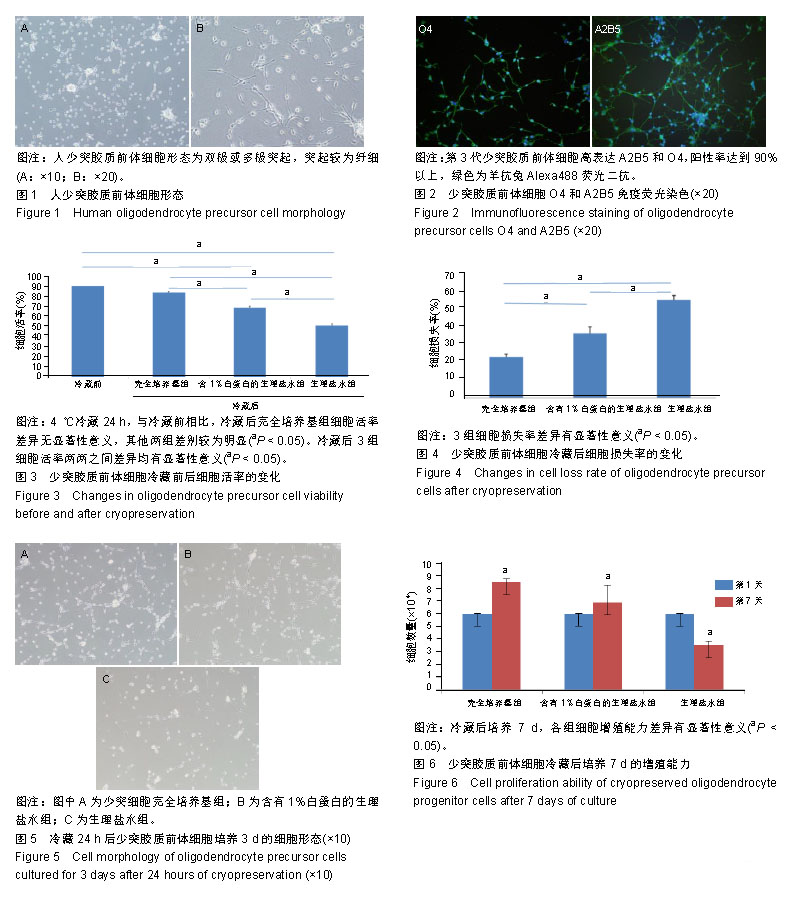| [1]Domingues HS, Cruz A, Chan JR, et al. Mechanical plasticity during oligodendrocyte differentiation and myelination. Glia. 2018;66(1):5-14.[2]Mauney SA, Pietersen CY, Sonntag KC, et al. Differentiation of oligodendrocyte precursors is impaired in the prefrontal cortex in schizophrenia. Schizophr Res. 2015;169(1-3): 374-380.[3]Yang QK, Xiong JX, Yao ZX. Neuron-NG2 cell synapses: novel functions for regulating NG2 cell proliferation and differentiation. Biomed Res Int. 2013;2013:402843.[4]Lee Y, Morrison BM, Li Y, et al. Oligodendroglia metabolically support axons and contribute to neurodegeneration. Nature. 2012;487(7408):443-448.[5]Shimizu T, Osanai Y, Ikenaka K. Oligodendrocyte-Neuron Interactions: Impact on Myelination and Brain Function. Neurochem Res. 2018;43(1):190-194.[6]Miller RH. Oligodendrocyte origins. Trends Neurosci. 1996; 19(3):92-96.[7]Lin SC, Bergles DE. Synaptic signaling between neurons and glia. Glia. 2004;47(3):290-298.[8]Nishiyama A. Glial progenitor cells in normal and pathological states. Keio J Med.1998;47(4):205-208.[9]Scolding NJ, Pasquini M, Reingold SC, et al. Cell-based therapeutic strategies for multiple sclerosis. Brain. 2017; 140(11):2776-2796.[10]Assinck P, Duncan GJ, Plemel JR, et al. Myelinogenic Plasticity of Oligodendrocyte Precursor Cells following Spinal Cord Contusion Injury. J Neurosci. 2017;37(36):8635-8654.[11]Higman MA, Port JD, Beauchamp NJ Jr, et al. Reversible leukoencephalopathy associated with re-infusion of DMSO preserved stem cells. Bone Marrow Transplant. 2000;26(7): 797-800.[12]Arutyunyan IV, Strokova SО, Makarov АV, et al. DMSO-Free Cryopreservation of Human Umbilical Cord Tissue. Bull Exp Biol Med. 2018;166(1):155-162.[13]Yu NH, Chun SY, Ha YS, et al. Optimal Stem Cell Transporting Conditions to Maintain Cell Viability and Characteristics. Tissue Eng Regen Med. 2018;15(5): 639-647.[14]Correia C, Koshkin A, Carido M, et al. Effective Hypothermic Storage of Human Pluripotent Stem Cell-Derived Cardiomyocytes Compatible With Global Distribution of Cells for Clinical Applications and Toxicology Testing. Stem Cells Transl Med. 2016;5(5):658-669.[15]Lu?nik Z, Bertolin M, Breda C, et al. Preservation of Ocular Epithelial Limbal Stem Cells: The New Frontier in Regenerative Medicine. Adv Exp Med Biol. 2016;951: 179-189.[16]Van Wezel-Meijler G, Steggerda SJ, Leijser LM. Cranial ultrasonography in neonates: role and limitations. Semin Perinatol. 2010;34(1):28-38.[17]Back SA. White matter injury in the preterm infant: pathology and mechanisms. Acta Neuropathol. 2017;134(3):331-349.[18]Ma J, Bo SH, Lu XT, et al.Protective effects of carnosine on white matter damage induced by chronic cerebral hypoperfusion.Neural Regen Res. 2016;11(9):1438-1444.[19]Back SA, Luo NL, Borenstein NS, et al. Late oligodendrocyte progenitors coincide with the developmental window of vulnerability for human perinatal white matter injury. J Neurosci. 2001;21(4):1302-1312.[20]Back SA, Riddle A, McClure MM. Maturation-dependent vulnerability of perinatal white matter in premature birth. Stroke. 2007;38(2 Suppl):724-730.[21]Jin K, Xie L, Mao X, et al. Effect of human neural precursor cell transplantation on endogenous neurogenesis after focal cerebral ischemia in the rat. Brain Res. 2011;1374:56-62.[22]Tabakow P, Jarmundowicz W, Czapiga B, et al. Transplantation of autologous olfactory ensheathing cells in complete human spinal cord injury. Cell Transplant. 2013; 22(9):1591-1612.[23]Huang H, Chen L, Xi H, et al. Fetal olfactory ensheathing cells transplantation in amyotrophic lateral sclerosis patients: a controlled pilot study. Clin Transplant. 2008;22(6):710-718.[24]Zhao K, Li R, Bi S, et al.Combination of mild therapeutic hypothermia and adipose-derived stem cells for ischemic brain injury.Neural Regen Res. 2018;13(10):1759-1770.[25]Huang H, Chen L. Commentary: Neurorestoratology: A Concept and Emerging Discipline in the Treatment of Neurological Disorders. CNS Neurol Disord Drug Targets. 2016;15(5):522-525.[26]黄红云,毛更生,陈琳. 神经修复临床细胞治疗现状与展望[J].中华细胞与干细胞杂志(电子版), 2017,7(3):162-167.[27]Song CG, Zhang YZ, Wu HN, et al.Stem cells: a promising candidate to treat neurological disorders.Neural Regen Res. 2018;13(7):1294-1304.[28]Faulkner J, Keirstead HS. Human embryonic stem cell-derived oligodendrocyte progenitors for the treatment of spinal cord injury. Transpl Immunol. 2005;15(2):131-142.[29]Rao RC, Boyd J, Padmanabhan R, et al. Efficient serum-free derivation of oligodendrocyte precursors from neural stem cell-enriched cultures. Stem Cells. 2009;27(1):116-125.[30]Neri M, Maderna C, Ferrari D, et al. Robust generation of oligodendrocyte progenitors from human neural stem cells and engraftment in experimental demyelination models in mice. PLoS One. 2010;5(4):e10145.[31]Wang C, Luan Z, Yang Y, et al. High purity of human oligodendrocyte progenitor cells obtained from neural stem cells: suitable for clinical application. J Neurosci Methods. 2015;240:61-66.[32]中国医药生物技术协会.干细胞制剂制备质量管理自律规范[J].中国医药生物技术,2016,11(6):481-490.[33]陈海丹.干细胞临床研究政策回顾和展望[J].自然辩证法通讯, 2018,40(3):81-86.[34]Mohamadnejad M, Alimoghaddam K, Mohyeddin-Bonab M, et al. Phase 1 trial of autologous bone marrow mesenchymal stem cell transplantation in patients with decompensated liver cirrhosis. Arch Iran Med. 2007;10(4):459-466.[35]Mohyeddin-Bonab M, Mohamad-Hassani MR, Alimoghaddam K, et al. Autologous in vitro expanded mesenchymal stem cell therapy for human old myocardial infarction. Arch Iran Med. 2007;10(4):467-473.[36]Venkataramana NK, Kumar SK, Balaraju S, et al. Open-labeled study of unilateral autologous bone-marrow- derived mesenchymal stem cell transplantation in Parkinson's disease. Transl Res. 2010;155(2):62-70.[37]Wang D, Zhang F, Shen W, et al. Mesenchymal stem cell injection ameliorates the inducibility of ventricular arrhythmias after myocardial infarction in rats. Int J Cardiol. 2011;152(3): 314-320.[38]Zhang F, Ren H, Shao X, et al. Preservation media, durations and cell concentrations of short-term storage affect key features of human adipose-derived mesenchymal stem cells for therapeutic application. PeerJ. 2017;5:e3301.[39]Wu YD, Li M, Liao X, et al. Effects of storage culture media, temperature and duration on human adipose?derived stem cell viability for clinical use. Mol Med Rep. 2019;19(3): 2189-2201.[40]Robinson NJ, Picken A, Coopman K. Low temperature cell pausing: an alternative short-term preservation method for use in cell therapies including stem cell applications. Biotechnol Lett. 2014;36(2):201-209. [41]Petrenko Y, Chudickova M, Vackova I, et al. Clinically Relevant Solution for the Hypothermic Storage and Transportation of Human Multipotent Mesenchymal Stromal Cells. Stem Cells Int. 2019;2019:5909524.[42]Utheim OA, Lyberg T, Eidet JR, et al. Effect of Transportation on Cultured Limbal Epithelial Sheets for Worldwide Treatment of Limbal Stem Cell Deficiency. Sci Rep. 2018;8(1):10502.[43]Campbell LH, Taylor MJ, Brockbank KG. Survey of Apoptosis After Hypothermic Storage of a Pancreatic β-Cell Line. Biopreserv Biobank. 2016;14(4):271-278.[44]Pless-Petig G, Rauen U. Serum-Free Cryopreservation of Primary Rat Hepatocytes in a Modified Cold Storage Solution: Improvement of Cell Attachment and Function. Biopreserv Biobank. 2018;16(4):285-295. |
.jpg)

.jpg)
.jpg)